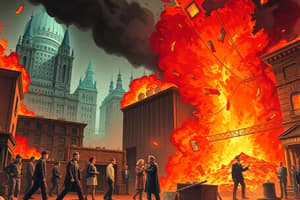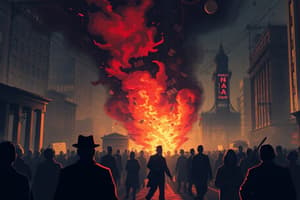Podcast
Questions and Answers
What significant event marked the beginning of the Great Depression on 24th October 1929?
What significant event marked the beginning of the Great Depression on 24th October 1929?
Black Thursday, when selling of shares began in earnest.
What role did banks play during the initial phase of the stock market crash?
What role did banks play during the initial phase of the stock market crash?
Banks continued to buy shares, believing the situation would improve.
What was the total percentage loss of share value from the stock market crash by 1932?
What was the total percentage loss of share value from the stock market crash by 1932?
Share prices lost 80% of their value.
What was one of the most severe consequences of the stock market crash for banks?
What was one of the most severe consequences of the stock market crash for banks?
How did the stock market crash affect unemployment in the United States by 1933?
How did the stock market crash affect unemployment in the United States by 1933?
What happened to the sales of manufactured goods following the crash?
What happened to the sales of manufactured goods following the crash?
What was a common experience for many unemployed individuals during the Great Depression?
What was a common experience for many unemployed individuals during the Great Depression?
What were the immediate financial effects on businesses after the crash, and how did this impact new company formation?
What were the immediate financial effects on businesses after the crash, and how did this impact new company formation?
Flashcards are hidden until you start studying
Study Notes
Background of the Stock Market Crash
- In 1929, foreseeing an over-production crisis, astute investors began selling their shares.
- A decline in confidence led to a lack of buyers, culminating in the stock market crash in October.
Key Events of the Crash
- Black Thursday, October 24, 1929: Significant selling of shares commenced but was initially dismissed as some shares gained value.
- Banks, believing the situation stable, not only refrained from action but started purchasing shares.
Consequences of the Crash
- A severe market collapse occurred on Tuesday, October 29, 1929, marking a definitive turn in the crisis.
- Share prices plummeted by 80% until 1932, signaling widespread financial instability.
Impact on Banking and Economy
- The crash triggered the closure of 5,000 banks in the following years, devastating Americans’ savings.
- The destruction of countless companies ensued due to their inability to finance debts, leading to further economic decline.
- With banking collapse, borrowing became unfeasible, stifling the inception of new companies.
Employment and Social Effects
- Sales of manufactured goods dropped by 80%, resulting in reduced investments and consumer demand.
- Unemployment soared to 14 million by 1933, with certain areas reporting unemployment rates as high as 30%.
- Many individuals, referred to as 'Hoboes,' wandered the country seeking work, often resorting to illegal travel methods on freight trains.
Studying That Suits You
Use AI to generate personalized quizzes and flashcards to suit your learning preferences.




